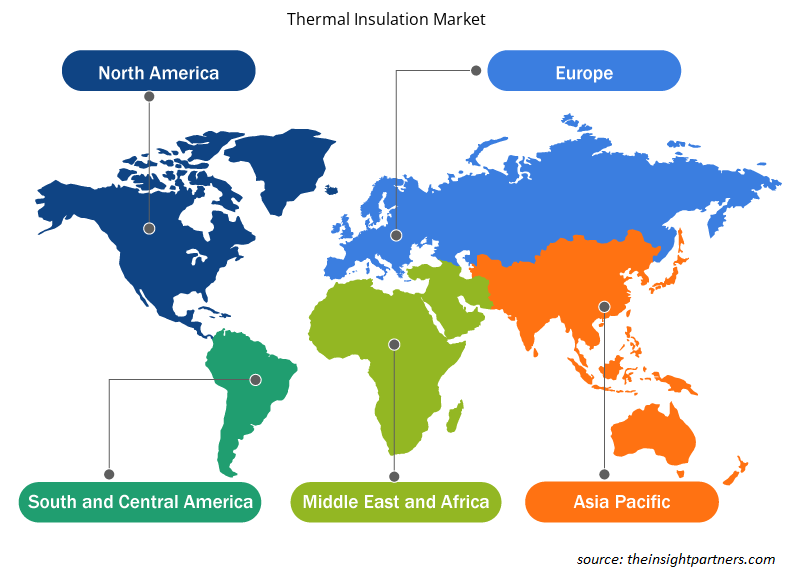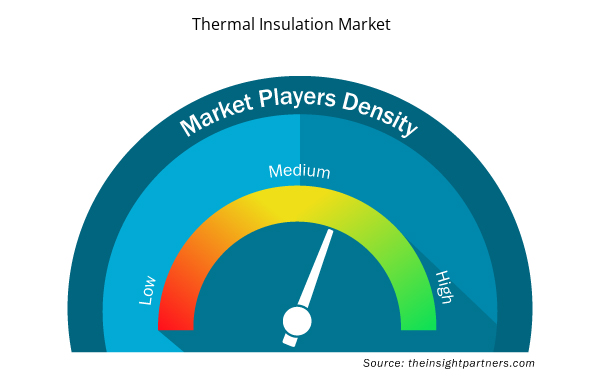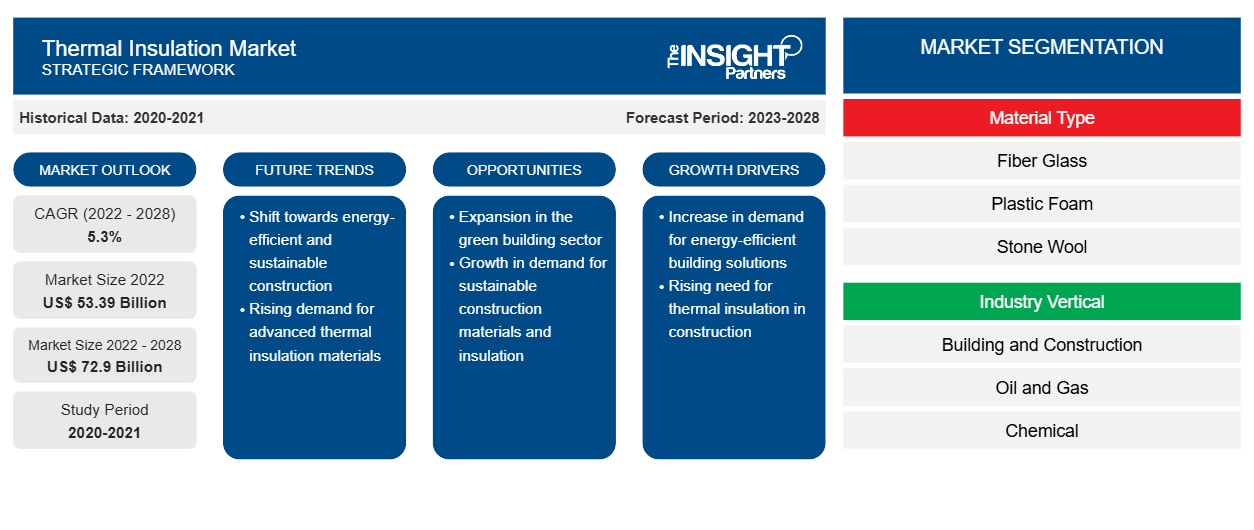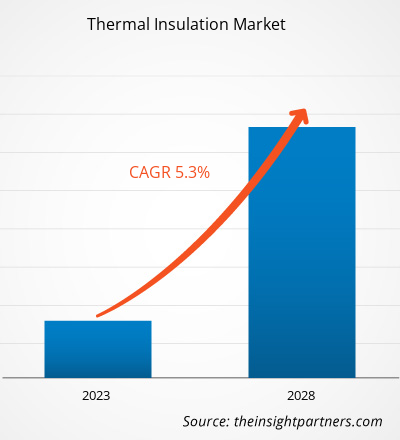Si prevede che il mercato dell'isolamento termico crescerà da 53,39 miliardi di dollari nel 2022 a 72,90 miliardi di dollari entro il 2028; si prevede che crescerà a un CAGR del 5,3% dal 2022 al 2028.
La domanda di isolamento termico è aumentata grazie ai suoi vantaggi. Riduce i costi energetici e il trasferimento di calore tra due oggetti di temperature diverse. Il materiale di isolamento termico offre un isolamento in cui il calore radiativo viene riflesso, ridotto e assorbito. Le aziende si stanno concentrando sulla fornitura di prodotti leggeri come la plastica, poiché è facile da installare e richiede meno tempo e sforzi. Si prevede che questi fattori aumenteranno la crescita del mercato dell'isolamento termico .
Si prevede che il mercato dell'isolamento termico registrerà una crescita significativa nei prossimi anni grazie alla forte presenza di attori di spicco, come BASF SE, Bayer AG, ROCKWOOL A/S, Johns Manville, SAINT GOBAIN SA, Kingspan Group PLC, Dow Chemicals Company, Owens Corning, Asahi Kasei Corporation e DuPont. Un'ampia varietà di prodotti per l'isolamento termico ha attirato l'attenzione dei consumatori. La crescente consapevolezza dei vantaggi dell'isolamento ad alta temperatura, tra cui la resistenza alle temperature elevate e agli shock termici, la bassa conduttività termica, i vantaggi ambientali e l'efficienza dei costi, probabilmente spingerà la crescita del mercato dell'isolamento termico nel periodo di previsione.
Nel 2021, l'Asia Pacifica deteneva la quota maggiore del mercato globale dell'isolamento termico. Tuttavia, si stima che il Nord America registrerà il CAGR più elevato nel mercato durante il periodo di previsione. Il mercato APAC è segmentato in Cina, India, Australia, Giappone, Corea del Sud e resto dell'APAC. L'industria edile è una delle industrie in forte espansione nell'APAC a causa della rapida crescita della popolazione; ciò porta in ultima analisi all'elevata domanda di prodotti per l'isolamento termico. Inoltre, i crescenti livelli di reddito disponibile dei consumatori e la crescita della popolazione della classe media sono alcuni dei fattori chiave che guidano la crescita del mercato dell'isolamento termico nella regione.
Personalizza questo report in base alle tue esigenze
Riceverai la personalizzazione gratuita di qualsiasi report, comprese parti di questo report, o analisi a livello nazionale, pacchetto dati Excel, oltre a usufruire di grandi offerte e sconti per start-up e università
- Scopri le principali tendenze di mercato in questo rapporto.Questo campione GRATUITO includerà analisi di dati che spaziano dalle tendenze di mercato alle stime e alle previsioni.
Impatto della pandemia di COVID-19 sul mercato dell'isolamento termico
Prima della pandemia di COVID-19, la crescita del mercato dell'isolamento termico era principalmente guidata dalla crescente domanda di edifici e attività di costruzione. Tuttavia, il mercato ha dovuto affrontare ostacoli durante il primo trimestre del 2020 a causa della chiusura delle attività, della carenza di materie prime e manodopera e del calo delle attività di costruzione e trasporto. La pandemia di COVID-19 ha portato alla recessione economica nei primi mesi del 2020, il che ha creato difficoltà finanziarie per i consumatori a basso e medio reddito.
Inoltre, a causa delle restrizioni, la chiusura di molte aziende edili e manifatturiere ha influenzato la crescita del mercato dell'isolamento termico. Inoltre, durante la pandemia, la carenza di manodopera è stata una delle principali preoccupazioni per il settore dell'isolamento termico. Ciò ha portato a uno spostamento verso la meccanizzazione, l'automazione e la fabbricazione fuori sede nel settore dell'isolamento termico.
Approfondimenti di mercato
Vantaggi dell'utilizzo dell'isolamento termico
L'isolamento termico riduce i movimenti di calore e la condensazione del vapore. Pertanto, previene l'umidità, la muffa, il congelamento, la deformazione che può verificarsi nell'edificio e l'indebolimento delle parti in ferro dovuto alla corrosione; e aiuta la conservazione dell'edificio. Inoltre, in vari settori, si possono ottenere enormi vantaggi in termini di risparmio energetico con una ridotta conduttività termica nella costruzione del rivestimento tramite l'utilizzo di prodotti come l'isolamento BTU-BLOCK.
In base al tipo di materiale, il mercato globale è suddiviso in fibra di vetro , schiuma di plastica, lana di roccia, silicato di calcio, vetro cellulare e altri. Nel 2021, il segmento della fibra di vetro ha rappresentato la quota di fatturato maggiore e si prevede che la schiuma di plastica rappresenti il tasso di crescita più elevato nel periodo di previsione. In base al settore verticale, il mercato globale è suddiviso in edilizia e costruzioni, petrolio e gas, chimica, aerospaziale e difesa, automotive, farmaceutica e altri. Il segmento dell'edilizia e delle costruzioni ha rappresentato la quota di fatturato maggiore.
BASF SE, Bayer AG, ROCKWOOL A/S, Johns Manville, SAINT GOBAIN SA, Kingspan Group PLC, Dow Chemicals Company, Owens Corning, Asahi Kasei Corporation e DuPont sono alcuni dei principali attori che operano nel mercato dell'isolamento termico. Queste aziende forniscono un'ampia gamma di portafogli di prodotti per il mercato. Le aziende sono presenti nelle regioni in via di sviluppo, offrendo opportunità di mercato redditizie. Gli attori del mercato stanno sviluppando prodotti innovativi e di alta qualità per soddisfare i requisiti dei clienti.
Segnala i riflettori
- Tendenze industriali progressive nel mercato per aiutare gli operatori a sviluppare strategie efficaci a lungo termine
- Strategie di crescita aziendale adottate dai mercati sviluppati e in via di sviluppo
- Analisi quantitativa delle dimensioni del mercato dei prodotti di isolamento termico dal 2022 al 2028
- Stima della domanda globale di isolamento termico
- Analisi PEST per illustrare l'efficacia degli acquirenti e dei fornitori che operano nel settore
- Sviluppi recenti per comprendere lo scenario competitivo del mercato
- Tendenze e prospettive di mercato e fattori che guidano e frenano la crescita del mercato dell'isolamento termico
- Assistenza nel processo decisionale evidenziando le strategie di mercato che sostengono l'interesse commerciale, portando alla crescita del mercato
- La dimensione del mercato dell'isolamento termico nei vari nodi
- Panoramica dettagliata e segmentazione del mercato, nonché dinamiche del settore dell'isolamento termico
- Dimensioni del mercato dell'isolamento termico in varie regioni con promettenti opportunità di crescita
Approfondimenti regionali sul mercato dell'isolamento termico
Le tendenze regionali e i fattori che influenzano il mercato dell'isolamento termico durante il periodo di previsione sono stati ampiamente spiegati dagli analisti di Insight Partners. Questa sezione discute anche i segmenti e la geografia del mercato dell'isolamento termico in Nord America, Europa, Asia Pacifico, Medio Oriente e Africa e America meridionale e centrale.

- Ottieni i dati specifici regionali per il mercato dell'isolamento termico
Ambito del rapporto sul mercato dell'isolamento termico
| Attributo del report | Dettagli |
|---|---|
| Dimensioni del mercato nel 2022 | 53,39 miliardi di dollari USA |
| Dimensioni del mercato entro il 2028 | 72,9 miliardi di dollari USA |
| CAGR globale (2022 - 2028) | 5,3% |
| Dati storici | 2020-2021 |
| Periodo di previsione | 2023-2028 |
| Segmenti coperti | Per tipo di materiale
|
| Regioni e Paesi coperti | America del Nord
|
| Leader di mercato e profili aziendali chiave |
|
Attori del mercato dell'isolamento termico Densità: comprendere il suo impatto sulle dinamiche aziendali
Il mercato dell'isolamento termico sta crescendo rapidamente, spinto dalla crescente domanda degli utenti finali dovuta a fattori quali l'evoluzione delle preferenze dei consumatori, i progressi tecnologici e una maggiore consapevolezza dei vantaggi del prodotto. Con l'aumento della domanda, le aziende stanno ampliando le loro offerte, innovando per soddisfare le esigenze dei consumatori e capitalizzando sulle tendenze emergenti, il che alimenta ulteriormente la crescita del mercato.
La densità degli operatori di mercato si riferisce alla distribuzione di aziende o società che operano in un particolare mercato o settore. Indica quanti concorrenti (operatori di mercato) sono presenti in un dato spazio di mercato in relazione alle sue dimensioni o al valore di mercato totale.
Le principali aziende che operano nel mercato dell'isolamento termico sono:
- BASF SE
- Bayer AG
- Lana di roccia A/S
- Giovanni Manville
- SAINT-GOBAIN SA
Disclaimer : le aziende elencate sopra non sono classificate secondo un ordine particolare.

- Ottieni una panoramica dei principali attori del mercato dell'isolamento termico
"Thermal Insulation Market Analysis to 2028" è uno studio specializzato e approfondito del settore dei beni di consumo con un'attenzione particolare all'analisi delle tendenze del mercato globale dell'isolamento termico. Il rapporto mira a fornire una panoramica del mercato con una segmentazione di mercato dettagliata.
Il mercato dell'isolamento termico è segmentato in base al tipo di materiale, al settore verticale e alla geografia. In base al tipo di materiale, il mercato globale è segmentato in fibra di vetro, schiuma di plastica, lana di roccia, silicato di calcio, vetro cellulare e altri. In base al settore verticale, il mercato globale è segmentato in edilizia e costruzioni, petrolio e gas, chimica, aerospaziale e difesa, automotive, farmaceutica e altri. In base alla geografia, il mercato è ampiamente segmentato in Nord America, Europa, Asia Pacifico (APAC), Medio Oriente e Africa (MEA) e Sud e Centro America.
Profili aziendali
BASF SE, Bayer AG, ROCKWOOL A/S, Johns Manville, SAINT GOBAIN SA, Kingspan Group PLC, Dow Chemicals Company, Owens Corning, Asahi Kasei Corporation e DuPont sono i principali attori che operano nel mercato globale dell'isolamento termico.
- Analisi storica (2 anni), anno base, previsione (7 anni) con CAGR
- Analisi PEST e SWOT
- Valore/volume delle dimensioni del mercato - Globale, regionale, nazionale
- Industria e panorama competitivo
- Set di dati Excel



Report Coverage
Revenue forecast, Company Analysis, Industry landscape, Growth factors, and Trends

Segment Covered
This text is related
to segments covered.

Regional Scope
North America, Europe, Asia Pacific, Middle East & Africa, South & Central America

Country Scope
This text is related
to country scope.
Domande frequenti
Based on the industry vertical, building and construction segment accounted for the highest share of the global market in 2021. Thermal insulation materials are increasingly used in the building and construction sector as they slow heat transfer through the enclosure to reduce heat gain and loss. Thermal insulation is increasingly becoming an essential technology to reduce energy consumption in buildings by preventing heat gain/loss through the building envelope.
Increasing demand for high-temperature thermal insulation is a recent trend in the global thermal insulation market. Growing awareness about the benefits of high-temperature insulation, including resistance to elevated temperatures and thermal shocks, low thermal conductivity, environmental benefits, and cost efficiency, is likely to propel the thermal insulation market growth over the forecast period. In addition, thermal insulation can protect equipment and help achieve extraordinarily high or low temperatures with reduced accident risks.
Based on the material type, plastic foam is expected to be the fastest-growing segment during the forecast period. Plastic foams are a type of polymer that includes voids and cells within the polymers. It is a lightweight cellular foam that is increasingly used as an insulation material.
Increase in demand for lightweight thermal insulation and growth in the building and construction industry are drivers of thermal insulation. Thermal insulation material offers insulation in which the radiative heat is reflected, reduced, and absorbed. Thermal insulation is a powerful technology that is used to reduce energy consumption in buildings by preventing heat gains or losses through the building covering.
The major players operating in the global thermal insulation market BASF SE, Bayer AG, ROCKWOOL A/S, Johns Manville, SAINT GOBAIN S.A, Kingspan Group PLC, Dow Chemicals Company, Owens Corning, Asahi Kasei Corporation, and DuPont.
In 2021, Asia Pacific accounted for the largest share of the global thermal insulation market. The Asia Pacific thermal insulation market is segmented into China, India, Japan, South Korea, Australia, and the Rest of Asia Pacific. These countries are witnessing growth in various end-use industries which will boost the growth of the thermal insulation market in the region. Growing urbanization in the emerging economies of Asia Pacific has led to an increased requirement for better commercial and public infrastructure. Rural-to-urban migration in developing countries in the region is increasing the construction activity in urban areas. As urban buildings are usually more insulation intensive than those in rural areas, this will, in turn, stimulate demand for thermal insulation in residential buildings.
Trends and growth analysis reports related to Chemicals and Materials : READ MORE..
The List of Companies - Thermal Insulation Market
- BASF SE
- Bayer AG
- ROCKWOOL A/S
- Johns Manville
- SAINT GOBAIN S.A
- Kingspan Group PLC
- Dow Chemicals Company
- Owens Corning
- Asahi Kasei Corporation
- DuPont
The Insight Partners performs research in 4 major stages: Data Collection & Secondary Research, Primary Research, Data Analysis and Data Triangulation & Final Review.
- Data Collection and Secondary Research:
As a market research and consulting firm operating from a decade, we have published and advised several client across the globe. First step for any study will start with an assessment of currently available data and insights from existing reports. Further, historical and current market information is collected from Investor Presentations, Annual Reports, SEC Filings, etc., and other information related to company’s performance and market positioning are gathered from Paid Databases (Factiva, Hoovers, and Reuters) and various other publications available in public domain.
Several associations trade associates, technical forums, institutes, societies and organization are accessed to gain technical as well as market related insights through their publications such as research papers, blogs and press releases related to the studies are referred to get cues about the market. Further, white papers, journals, magazines, and other news articles published in last 3 years are scrutinized and analyzed to understand the current market trends.
- Primary Research:
The primarily interview analysis comprise of data obtained from industry participants interview and answers to survey questions gathered by in-house primary team.
For primary research, interviews are conducted with industry experts/CEOs/Marketing Managers/VPs/Subject Matter Experts from both demand and supply side to get a 360-degree view of the market. The primary team conducts several interviews based on the complexity of the markets to understand the various market trends and dynamics which makes research more credible and precise.
A typical research interview fulfils the following functions:
- Provides first-hand information on the market size, market trends, growth trends, competitive landscape, and outlook
- Validates and strengthens in-house secondary research findings
- Develops the analysis team’s expertise and market understanding
Primary research involves email interactions and telephone interviews for each market, category, segment, and sub-segment across geographies. The participants who typically take part in such a process include, but are not limited to:
- Industry participants: VPs, business development managers, market intelligence managers and national sales managers
- Outside experts: Valuation experts, research analysts and key opinion leaders specializing in the electronics and semiconductor industry.
Below is the breakup of our primary respondents by company, designation, and region:

Once we receive the confirmation from primary research sources or primary respondents, we finalize the base year market estimation and forecast the data as per the macroeconomic and microeconomic factors assessed during data collection.
- Data Analysis:
Once data is validated through both secondary as well as primary respondents, we finalize the market estimations by hypothesis formulation and factor analysis at regional and country level.
- Macro-Economic Factor Analysis:
We analyse macroeconomic indicators such the gross domestic product (GDP), increase in the demand for goods and services across industries, technological advancement, regional economic growth, governmental policies, the influence of COVID-19, PEST analysis, and other aspects. This analysis aids in setting benchmarks for various nations/regions and approximating market splits. Additionally, the general trend of the aforementioned components aid in determining the market's development possibilities.
- Country Level Data:
Various factors that are especially aligned to the country are taken into account to determine the market size for a certain area and country, including the presence of vendors, such as headquarters and offices, the country's GDP, demand patterns, and industry growth. To comprehend the market dynamics for the nation, a number of growth variables, inhibitors, application areas, and current market trends are researched. The aforementioned elements aid in determining the country's overall market's growth potential.
- Company Profile:
The “Table of Contents” is formulated by listing and analyzing more than 25 - 30 companies operating in the market ecosystem across geographies. However, we profile only 10 companies as a standard practice in our syndicate reports. These 10 companies comprise leading, emerging, and regional players. Nonetheless, our analysis is not restricted to the 10 listed companies, we also analyze other companies present in the market to develop a holistic view and understand the prevailing trends. The “Company Profiles” section in the report covers key facts, business description, products & services, financial information, SWOT analysis, and key developments. The financial information presented is extracted from the annual reports and official documents of the publicly listed companies. Upon collecting the information for the sections of respective companies, we verify them via various primary sources and then compile the data in respective company profiles. The company level information helps us in deriving the base number as well as in forecasting the market size.
- Developing Base Number:
Aggregation of sales statistics (2020-2022) and macro-economic factor, and other secondary and primary research insights are utilized to arrive at base number and related market shares for 2022. The data gaps are identified in this step and relevant market data is analyzed, collected from paid primary interviews or databases. On finalizing the base year market size, forecasts are developed on the basis of macro-economic, industry and market growth factors and company level analysis.
- Data Triangulation and Final Review:
The market findings and base year market size calculations are validated from supply as well as demand side. Demand side validations are based on macro-economic factor analysis and benchmarks for respective regions and countries. In case of supply side validations, revenues of major companies are estimated (in case not available) based on industry benchmark, approximate number of employees, product portfolio, and primary interviews revenues are gathered. Further revenue from target product/service segment is assessed to avoid overshooting of market statistics. In case of heavy deviations between supply and demand side values, all thes steps are repeated to achieve synchronization.
We follow an iterative model, wherein we share our research findings with Subject Matter Experts (SME’s) and Key Opinion Leaders (KOLs) until consensus view of the market is not formulated – this model negates any drastic deviation in the opinions of experts. Only validated and universally acceptable research findings are quoted in our reports.
We have important check points that we use to validate our research findings – which we call – data triangulation, where we validate the information, we generate from secondary sources with primary interviews and then we re-validate with our internal data bases and Subject matter experts. This comprehensive model enables us to deliver high quality, reliable data in shortest possible time.


 Ottieni un campione gratuito per questo repot
Ottieni un campione gratuito per questo repot